Abstract
Intelligent building management systems are proven to lead to energy savings and are an integral component of smart buildings. The procedures developed in the EN standards describe the methodology for calculating the energy savings achieved by improving the automation and control levels of separate services in building systems. However, although this method is used in practice, it is rarely applied or investigated by the research community. Typically, energy savings resulting from a single automation improvement intervention in a building heating system are observed, while the holistic view of combined automation upgrades is not considered. Therefore, the purpose of this study was to assess the energy savings resulting from several upgrades to control levels in the heating system components of the building. In addition, this research provides a rationale for the impact of multiple automation and control options for heating systems as well as examines the difference in energy savings. Finally, an analytical model is developed and demonstrated to assess the feasibility of building automation and control upgrades, by determining the allowed investment according to a set of predefined indicators.
1. Introduction
Advancing sustainability in the built environment with the use of advanced methods for heating is among the main challenges of the scientific community of building engineering [1]. According to the Heat Roadmap Europe [2], improving heat networks is crucial for building energy efficiency. Three main categories of effective measures have been identified to improve the energy performance of buildings, namely reducing the building’s energy demand, ensuring energy-conscious occupant behavior, and adopting energy-efficient technologies and equipment [3]. The latter measures are currently the subject of extensive research, while new technologies such as the Internet of Things, with sensors and control devices, are rapidly penetrating the market [4].
The use of smart control technologies can save up to 70% of energy in heating systems [3]. Improvements to different heating service control levels are shown to add flexibility to the system, for example by allowing the introduction of renewable energy sources (RES) or enabling enhanced control by the user [5,6]. However, with the increasing availability of automation and control systems, there is a need for standardization of procedures for the implementation and quantification of control benefits [3,7]. The ISO 52120-1:2022 standard [8] gives guidance for assessing the effect of automation and control upgrades on the energy performance of building systems. However, the standard only provides the methodology for the assessment of individual building system service energy savings and does not provide a method showing how to perform this assessment holistically.
Several studies have analyzed the energy savings that can be achieved by improving the level of control based on the EN 15232 standard, which has recently been replaced by ISO 52120-1:2022 [8]. A newly published study from Belgium [9] presented a comprehensive review evaluating the performance of a BACS factor method depicted in EN 15232 compared to simulation methods. It was concluded that the BACS factor method lacks the consideration of several influencing elements, where geographical location, including the climate zone, and user behavior are of the highest significance. This has been confirmed in several other studies performing the assessment using a simulation method [10,11,12]. However, the simulation method has been shown to have its own limitations. This is mainly due to the fact that it is usually difficult to obtain all the necessary data to perform a reliable estimate (some factors, such as human behavior, are still difficult to control) and that such an assessment requires a lot of experience [9,10]. Furthermore, some studies identified a lack of validation for simulation methods using real case studies [13]. Therefore, the BACS factor method is still considered as a viable option for estimating energy savings gained from control upgrades as well as to encourage a wider implementation of BACS in the design and retrofitting of buildings [9,12]. Still, no studies were found that suggest how the combination of different heating system control improvements can affect overall energy savings.
From another perspective, the decision of an owner or facility manager to upgrade the automation and control levels in heating systems is usually based on cost-optimality criteria [14]. Now, with the constantly expanding supply of various control solutions, high system efficiency can be reached with comparatively low investments [7]. However, it remains a challenge to determine a methodology to prioritize which control improvements in building heating services can result in the highest return. Furthermore, similarly to energy savings, a detailed assessment of the allowed investment requires the evaluation of many factors such as maintenance costs and other specifics regarding the individual building’s thermal performance [15,16]. To date, there were several studies found assessing the investment or pay-back criteria applying a case-study method [15,16,17]. Most of the authors agree that an upgrade in control options is an effective way to reach energy savings and is a simpler process in comparison to improvements or renovation of a building’s envelope. However, none of the studies were found to investigate all the possible options of the control upgrades and the calculations for the allowed investment for each case.
This study examines the impact of heating system automation and control level upgrades on the energy efficiency of buildings. In particular, it introduces a novel model, based on the ISO 52120 standard [8] approach, which quantifies the energy savings resulting from 60 possible building automation and control system (BACS) upgrade options using the calculated energy savings in a monetary form. The results of this study are presented in a replicable manner, allowing the definition of the specific maximum allowed investment, expressed as a percentage of energy costs. In this study, the allowed investment is calculated for each considered heating service control level upgrade, by assessing the proposed measures according to the principles of life cycle costing (LCC). This study also discusses the effect of multiple upgrades of automation and control systems on the energy efficiency of a building. The second section of this research provides the theoretical background regarding the main elements of the heating system and the available control levels, addressing the different BACS energy classes. In the third section, the methodology used to evaluate the energy savings and quantify the results is explained. The results and discussion section presents the outcomes of the model application, whereas the last section of this study resumes the main outcomes of the report.
2. Theoretical Background
Energy-efficient space heating systems are an integral element of sustainable buildings. In contemporary buildings, heating is regulated by multiple automation and control systems, which can significantly affect both the energy consumption and comfort conditions for building occupants. The ISO 52120-1:2022 [8] standard provides a common framework and procedures for the contribution of automation, control, and management systems to the energy performance of buildings. Based on the standard, space heating systems are divided into six key components: (1) a heat generator; (2) thermal energy storage; (3) an air handling unit; (4) a room; (5) a heating water supply; and (6) a heating water return.
These components can be further segregated into three main parts of heating systems, namely supply, distribution, and demand. For each component, there are several control options available (Figure 1).
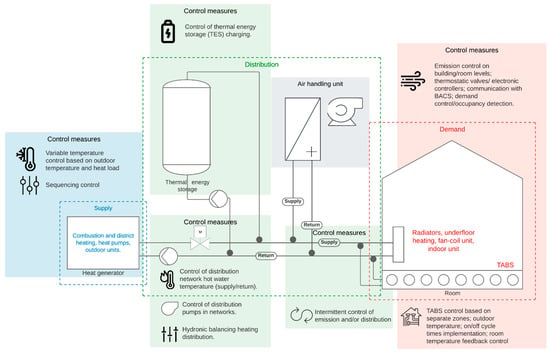
Figure 1.
Space heating system and available control measures. Adapted from ISO 52120-1:2022 [8].
2.1. Control of Heating Services on the Demand Side
From the demand side, the main type of heating control is emission control. Two types of emission control can be applied in building spaces.
The first type is emission control applied to the heat emitter (radiators, underfloor heating, fan-coils, or other indoor units) at that room level and this can be evaluated by means of rating from 0 to 4. The control level indicates the properties of the automation and control systems. For instance, level 0 indicates no automatic control of the room temperature, whereas level 4 represents an integrated control system able to control individual room temperature by communicating between controllers and BACS.
The second type of control on the demand side can be applied to thermally activated building systems (TABS) and is evaluated with a rating of 0 to 3. TABS is a combined heating and cooling system embedded in structural concrete slabs or walls in the form of pipes. As the TABS reaction time is considerably slower than that of convective systems, the main goal of the control systems is to optimize the temperature levels to achieve maximum comfort with the least energy expenditure. Therefore, moving up the scale of the level of control for TABS factors, availability to control separate TABS zones, evaluate the outside temperature, implement the of on/off cycle times, and room temperature feedback controls are taken into consideration.
2.2. Control of Heating Services on the Supply Side
On the supply side, heat generator control can be applied for combustion systems and district heating, as well as for heat pumps or outdoor units.
- The level of control of the heating generator is rated between 0 and 2. Control options applied on combustion systems and district heating, as well as on heat pumps, depend on the availability of variable temperature control, relying on the outside temperature and the heat load. For outdoor units, the level of control lies in the accessibility of heat generator control moving from the lowest level, where only on/off control is available to the variable control based on heat load or demand at the top level.
- If there are different heat generator sizes or types, sequencing control can be applied as well. Sequencing control is rated from 0 to 3, depending on the flexibility of the priority list and with data-driven decision making including prediction-based prioritization.
2.3. Control of Heating Services on the Distribution Side
Control measures are also available for the individual elements of the distribution part of the heating system.
- Charging control can be applied to thermal energy storage (TES) by introducing sensor devices into the system and implementing load prediction algorithms.
- The temperature of hot water in the distribution networks can also be controlled according to the outside temperature or the demand.
- Similarly, controls may be applied to distribution pumps in networks rated from 0 to 4. In this case, the main purpose of the control options is to reduce the auxiliary energy demand, which is the electrical energy used by technical building systems to support the transformation of energy to satisfy energy needs. The highest efficiency of the auxiliary energy demand can be achieved in the case of variable demand-based pump speed control.
- Emission can also be controlled on the distribution side, by hydronic balancing of the emitter or a group of emitters. The level of balancing control is measured from 0 to 4 and depends on the availability of dynamic control per emitter. Finally, intermittent control can be applied both on the emission and distribution sides of the network. The level of intermittent control is determined based on the development of automatic control measures.
2.4. Calculation Methods for the Influence of BACS on System Energy Efficiency
The ISO 52120-1:2022 standard [8] provides a calculation method to determine the influence of automation-level improvements on system energy savings. An integral part of the calculation process is the definition of the efficiency class of the heating-related BACS.
The methodology recognizes four efficiency classes—A, B, C, and D, where A represents the most energy-efficient BACS and TBMS and class D non-energy-efficient BACS. Each control function of BACS and TBMS in heating systems is assigned a representative energy class, depending on whether the building is residential or non-residential.
Energy savings in heating systems can be achieved by increasing the level of control. There are two evaluation methods of BACS influence on system energy efficiency. The first method includes detailed calculations, while the second one is factor based.
- The detailed method enables the evaluator to choose the yearly, monthly, or daily time interval for further calculations. There are five approaches available under the detailed method for the energy consumption calculations: the direct approach, the operating-mode approach, the time approaches, the setpoint approach, and the correction coefficient approach.
- In contrast, a factor-based method was established to simplify the evaluation process of the impact of the application of control measures on building energy performance. The factor-based method considers delivered energy as an input and applies BACS efficiency factors, to result in BACS adjustments to delivered energy as outputs.
The five approaches for the calculation of energy consumption in the detailed method and the adjusted factor-based method for only heating energy are represented in Figure 2. According to the factor-based method, BACS influence on energy efficiency in heating systems can be evaluated by the total heating energy (QH,tot,BAC) and the electrical auxiliary energy for heating (WH,aux,BAC) based on the BAC efficiency class. For the calculation process, it is suggested to use BACS efficiency class C as a reference value. The heating loads of the building may be calculated based on the ISO 52016-1 standard [18], whereas the thermal and auxiliary input to the space heating system can be calculated based on the EN 15316 series standards [19].
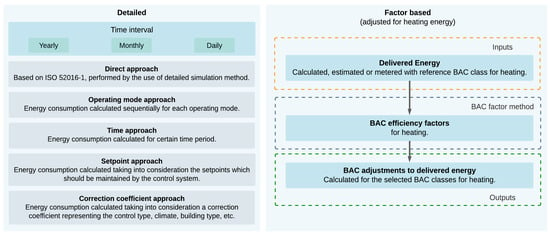
Figure 2.
Calculation methods for BACS influence on system energy efficiency. Adapted from ISO 52120-1:2022 [8].
The influence of BACS on energy efficiency in heating systems can be calculated using Equations (1) and (2):
Equation (1) presents the total heating energy based on the BACS efficiency class, whereas Equation (2) presents the electrical auxiliary energy for heating based on the BACS efficiency class.
3. Materials and Methods
To distinguish the impact of control level adjustments on the different parts of the heating system, an analysis was carried out for each possible control level upgrade examining residential apartment buildings. The heating system under analysis has eleven heating services, introduced in ISO 52120-1:2022 [8] (Figure 3).
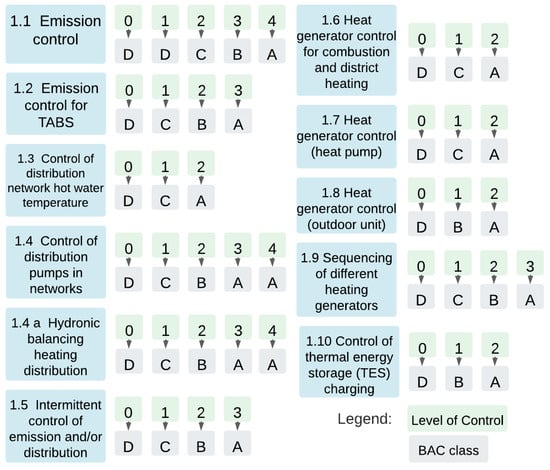
Figure 3.
The 11 heating systems, their available control levels, and the reflective BACS efficiency class. Adapted from ISO 52120-1:2022 [8].
Each service has been assigned a control level, expressed in a range from 0 to 4. In this case, level 0 represents the lowest level of control, while the other levels indicate certain improvements in system control. In general, an upgrade in the control level means an improvement that enables the system to achieve a higher level of automation (Figure A1). Subsequently, for each level of control, a reflective BACS efficiency class is assigned based on ISO 52120-1:2022 [8], ranging from A to D, with A being the highest efficiency class. It is not always the case that an upgrade in the control level results in an improvement in the BACS efficiency class. However, there are also cases where an upgrade in one control level results in an advance of two efficiency classes. Therefore, the transformation from a control level to a BAC efficiency class is not straightforward. This also affects the energy savings that can be achieved by upgrading the control levels.
Each BACS efficiency class may be expressed as a factor. The coefficients of the different efficiency classes depend on the type of building, whether it is residential or non-residential, and on the function of the building (apartment block, office, hotel, etc.). The lowest BAC efficiency class has the highest coefficient value, while the highest class has the lowest. In this case, residential apartment buildings were taken under analysis. The coefficient representing the BAC efficiency class of a class D, C, B and A residential apartment building is 1.1, 1, 0.88 and 0.81, respectively. This shows that a higher efficiency class leads to higher energy savings in the heating system. The exact factors for other types and functions of buildings are presented in ISO 52120-1:2022 [8].
To determine the factor by which the energy savings will be affected by the upgrade of the BACS equipment, the factor of the improved BACS efficiency class was divided by the reference class. So, for instance, heating system service 1.1 Emission control has control levels in a range from 0 to 4. From Figure 3, it can be seen that levels 0 and 1 are assigned to class D, level 2 to class C, level 3 to class B and level 4 to class A. Each class has a representative factor value introduced above for residential apartment buildings in a range from 1.1 to 0.81. There are 10 variations of control level upgrade possibilities for the service represented in Table 1. The energy saving factor was calculated by dividing the upgraded class coefficient by the reference class coefficient. For instance, the saving factor for upgrade from level 0 to level 1 is calculated by dividing 1.1 by 1.1, resulting in a saving factor equal to 1 and meaning that this upgrade will not bring any energy savings for the heating system (Table 1). These calculations were performed for each heating system service and the results are discussed in Section 4.

Table 1.
Variations of the emission control service level of control upgrades, calculated energy saving factors and normalized energy savings.
The reduction in heating system energy consumption was calculated by multiplying the current system’s energy consumption by the calculated energy saving factor, following Equation (3). Thus, energy savings in a system were found to be the difference between the current energy consumption and the reduced energy consumption. For example, if the energy consumption of a building for heating is 60 kWh/m2 per year, the upgrade in emission control service from level 0 to 2 would bring energy savings equal to energy consumption multiplied by a factor of 0.66 and subtracted from the initial consumption. The results were normalized as a percentage of the total system heating energy use (Table 1). Equation (3) presents the total heating energy based on the BAC efficiency class when the total heating energy needed for a building is known [8].
It is clear, that the biggest energy savings can be achieved by upgrading all parts of the heating system to the highest level of control. However, this approach would not be a cost-optimal one, as all upgrade options should be monetized and assessed for their feasibility. Therefore, it is important to quantify the savings in monetary terms and determine whether the investment can be justified. For the purpose of this study, the allowed investment for the estimated savings was determined based on the life cycle costing (LCC) principles, for a given discount rate of 3% in addition to an internal rate of return (IRR) of 10% for a defined period of 10 years. The results were then normalized as a percentage of the current energy price.
The method proposed above enables us to evaluate the influence of the BACS efficiency class on heating energy consumption in buildings and expresses it in monetary terms. However, this influence can be observed only for each heating service individually and does not consider a case where multiple control upgrades in the heating system are combined. Equation (4) proposes a calculation method for the total heating energy consumption based on BAC efficiency classes of several system services. According to the equation, the total consumption of heating energy based on different BAC efficiency classes can be evaluated by multiplying the initial energy consumption by the respective factors. For example, the reduction in energy consumption given that the energy use of a building is 60 kWh/m2 per year for three heating system service control level is upgraded from level 0 to 3 for emission control, from level 0 to 2 for distribution pumps in networks and from level 0 to 1 for heat generator control in outdoor units, calculated by multiplying the consumption with respective energy saving factors of 0.46, 0.53 and 0.53 (factors calculated according to the example in Table 1). To calculate the energy savings, the reduced energy consumption by the influence of control upgrades is subtracted from the initial consumption.
4. Results and Discussion
In this study, the energy savings in a heating system resulting from various control level upgrades were calculated and expressed as a percentage of the system’s energy use (Figure 4). The figure represents the energy savings that can be gained for separate heating services by different control level upgrades in residential apartment buildings for 60 possible cases in 11 heat services. The lowest amount of savings according to the estimates is 9% and, as a rule, this can be achieved by increasing the level of control from level 0 to level 1. However, in some heating services, energy savings of up to 20% are observed for the same level upgrade. The highest amount of savings available to gain from an upgrade in heating service is 26% and most likely occurs when upgrading from level 2 to 3 or from level 3 to 4.
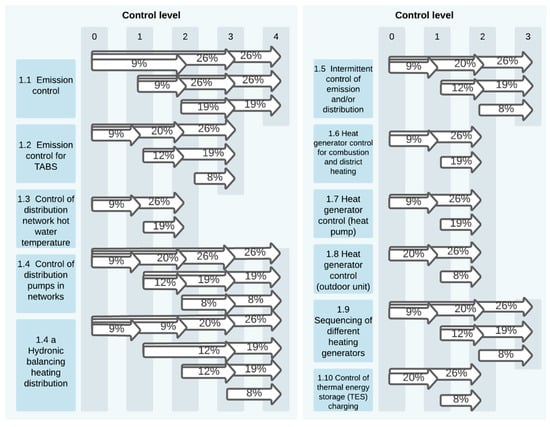
Figure 4.
Potential savings for separate heating service control level upgrades for residential apartment buildings.
As energy savings are normalized by recalculating them as a percentage of total energy use, they become a constant, regardless of the energy consumption of the heating system. In this case, the savings were calculated using residential apartment buildings BACS efficiency factors; however, the estimations can be seamlessly replicated for any function of buildings based on ISO 52120-1:2022 [8]. This enables determining the best possible upgrade for the control level in terms of energy efficiency. For instance, for the first heating service—emission control—it can be observed that moving from level 0 to level 3 brings the same amount of savings, 26%, as moving from level 0 to 4.
This would indicate to the owner that no additional energy savings can be expected by upgrading the level of control from level 3 to 4. Furthermore, it is clear that, for some services, a less significant upgrade brings higher energy savings. For example, upgrading the heating generator control for heat pumps from level 0 to 1 results in savings of 9%, while upgrading the heating generator control for outdoor units for the same level results in savings of 20%. This indicates that an upgrade to a certain level for a specific heating service might be more energy efficient than to another.
The decision criterion for the level of control upgrades is the financial feasibility of the investment. For example, the upgrade of emission control, as well as the control of distribution pumps in networks to the highest level of control from level 0, achieves energy savings of 26%. However, the costs of technical equipment and installation can significantly differ. Therefore, for a cost-optimal approach, the financial performance of the proposed solutions in terms of LCC should be identified. At the same time, it is important to determine the allowed investment for each upgrade to ensure the desired return. Consequently, the allowed investment for each heating service control upgrade was evaluated for a given discount rate of 3% and an IRR of 10% over a specific period of 10 years.
Figure 5 represents the allowed investment for each upgrade in different heating services for residential apartment buildings. The allowed investment was also normalized as a percentage of the heating energy costs. Based on the calculations, the lowest allowed investment for a respective control level upgrade is 62% and the highest is 183% of the energy costs, respectively. Naturally, by altering the predefined parameters of the interest rate, the IRR, and the period, the allowed investment differs. Lower interest rates and a lower IRR would also result in a reduction in the allowed investment. Similarly, decreasing the period in half with the same interest rate and the IRR allowed investment decreases by approximately 40%.
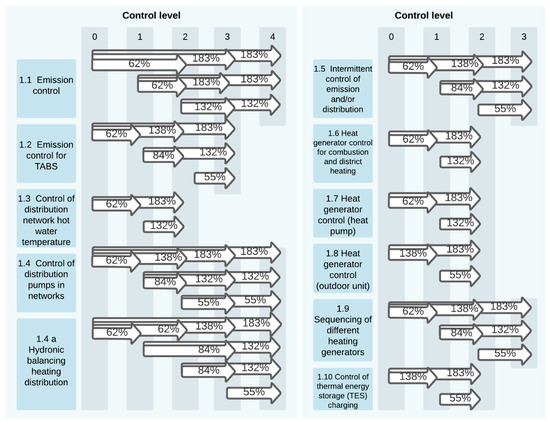
Figure 5.
Allowed investment for upgrades to the control level of separate heating services for residential apartment buildings.
The results described above allow only for the evaluation of each heating service separately. However, in some cases, higher energy savings can be achieved by combining different upgrades to the heating system services rather than maximizing the level of control in one. Therefore, based on the results presented in Figure 4, the decision can be taken for several lower-level improvements throughout the system, to maximize energy savings. Based on the available energy savings from individual control improvements, a decision for the upgrade, e.g., of the emission control to only level 3 instead of up to the highest emission control level. Furthermore, the control of distribution pumps in the networks can be upgraded to level 2, saving an additional 20%, and the control of outdoor heat generators to level 1, saving another 20%.
The total savings of the system in this case (also introduced in the methodology section), calculated using Equation (4), result in a total energy savings of 53%. This indicative example reveals that over half of the energy savings in the heating system can be achieved with just three improvements in the control levels of the respective heating services. This type of method for upgrades to heating service control enables evaluating the system holistically while at the same time considering the energy savings gained from a heating service upgrade and further estimating the additional upgrades moving from that point. Therefore, the recalculated allowed investment does not equal the sum of allowed investments for separate heating service control upgrades, as depicted in Figure 5.
The possibility of estimating the different combinations of the level of control upgrades, together with the financial feasibility evaluation by determining the allowed investment, enables a holistic building heating system assessment. By using this model, it is possible to determine the best balance between energy savings and investments for various levels of control upgrades in different services of the building’s heating system.
In the context of this research, it would be beneficial to estimate the costs of each service upgrade for separate levels of control upgrades. This would allow one to promptly evaluate the benefits in energy savings related to the specific upgrade costs. Furthermore, these measurements can further be used in simulating all the possibilities of control level upgrade in the heating system in consideration of the upgrade costs and allowed investment.
5. Conclusions and Future Work
This study investigated the potential energy savings in heating systems that can be utilized by introducing various improvements in the control levels of the heating services. It was found that an increase in the control level in a heating service does not always lead to an upgrade in the BAC efficiency class according to ISO 52120-1:2022, although it can result in increased energy savings. As part of the analysis, the energy savings for a series of possible control level upgrades in a heating system were calculated and expressed as a percentage of total energy consumption. The results show that the energy savings for individual heating services in residential apartment buildings can vary from 9 to 26%, depending on control level upgrade. Furthermore, the allowed investment for each heating service control level adjustment was calculated and normalized with respect to the energy costs. Considering an interest rate of 3% and a goal for an IRR of 10% over 10 years, the allowed investment varies from 62 to 183% per heating service of the separate control level upgrades in residential apartment buildings. It was also revealed that the total energy consumption of a building does not affect the allowed investment, thus it remains constant for given LCC input assumptions (the IRR, the discount rate, and time of assessment).
Moreover, to the authors’ knowledge, currently there are no methods available to investigate the influence of various control level upgrades on the heating system holistically. Hence, for this purpose, a calculation model was proposed. This study revealed that a combination of several upgrades, even at a lower level, can achieve higher savings than maximizing the control level for separate services. In the example, it was found that more than half (53%) of energy savings can be reached by only upgrading control levels in three heating services. This confirms what is known from experience in practice—focusing on one specific aspect of the controls, even if this is to the highest possible level, is not enough, since overall efficiency depends on the efficiencies of all the components and their smooth integration. As part of future work, specific ranges of costs for devices and installation work for each upgrade to the service control levels can be considered. This would result in a comprehensive model to support the decision-making process for different control-level upgrades. Additionally, it can be used to simulate all the possibilities of control upgrades with respect to energy savings and allowed investment, to determine the best possible scenarios of control upgrades in the heating system. Another topic that merits further investigation would be the connection of the approach of this study with the recently established Smart Readiness Indicator (SRI) methodology of the European Commission, for defining building smartness levels, based on automation and control [12]. The findings of this study can be used to identify the minimum requirements for SRI levels, based on the cost-optimal approach, given that six out of the nine service domains considered under the SRI methodology are also analyzed in the ISO 52120 standard.
Author Contributions
Conceptualization, P.A.F.; data curation, D.P.; formal analysis, L.M.; funding acquisition, A.J., P.A.F. and A.P.; investigation, L.M. and A.P.; project administration, P.A.F.; supervision, A.P.; validation, D.P.; writing—original draft, L.M. and A.J.; writing—review and editing, A.J. and P.A.F. All authors have read and agreed to the published version of the manuscript.
Funding
This study acknowledges funding support from the European Union’s Horizon 2020 research and innovation program “Development of Utilities Management Platform for the case of Quarantine and Lockdown” under the Marie Sklodowska-Curie grant agreement No 101007641.
Institutional Review Board Statement
Not applicable.
Informed Consent Statement
Not applicable.
Data Availability Statement
Not applicable.
Conflicts of Interest
The authors declare no conflict of interest.
Nomenclature
| Symbol | Description | Units |
| f | Efficiency | - |
| Q | Heating energy | W |
| W | Electrical energy | W |
| Abbreviation | Description | |
| BACS | Building automation and control system | |
| IRR | Internal rate of return | |
| LCC | Life cycle costing | |
| NPV | Net present value | |
| SRI | Smart Readiness Indicator | |
| TABS | Thermally activated building systems | |
| TBMS | Technical building management systems | |
| TES | Thermal energy storage | |
| Indicator | Description | |
| aux | Auxiliary | |
| B | Building | |
| BAC | Building automation and control | |
| el | Electricity | |
| H | Heating | |
| ls | Loss | |
| nd | Need | |
| hs | Heating system | |
| ref | Reference | |
| tot | Total | |
Appendix A
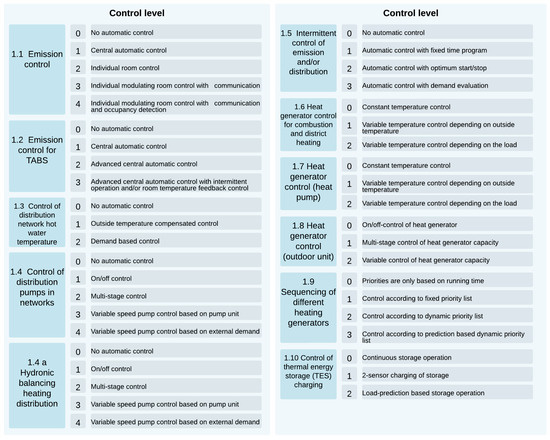
Figure A1.
BAC and TBM functions with an impact on the energy performance of buildings for heating control [8].
References
- Fokaides, P.A.; Apanaviciene, R.; Černeckiene, J.; Jurelionis, A.; Klumbyte, E.; Kriauciunaite-Neklejonoviene, V.; Pupeikis, D.; Rekus, D.; Sadauskiene, J.; Seduikyte, L.; et al. Research Challenges and Advancements in the field of Sustainable Energy Technologies in the Built Environment. Sustainability 2020, 12, 8417. [Google Scholar] [CrossRef]
- Heat Roadmaps–Heat Roadmap Europe. Available online: https://heatroadmap.eu/roadmaps/ (accessed on 6 May 2022).
- Chen, S.; Zhang, G.; Xia, X.; Setunge, S.; Shi, L. A review of internal and external influencing factors on energy efficiency design of buildings. Energy Build. 2020, 216, 109944. [Google Scholar] [CrossRef]
- Verma, A.; Prakash, S.; Srivastava, V.; Kumar, A.; Mukhopadhyay, S.C. Sensing, Controlling, and IoT Infrastructure in Smart Building: A Review. IEEE Sens. J. 2019, 19, 9036–9046. [Google Scholar] [CrossRef]
- Chen, Y.; Xu, P.; Gu, J.; Schmidt, F.; Li, W. Measures to improve energy demand flexibility in buildings for demand response (DR): A review. Energy Build. 2018, 177, 125–139. [Google Scholar] [CrossRef]
- Vandermeulen, A.; van der Heijde, B.; Helsen, L. Controlling district heating and cooling networks to unlock flexibility: A review. Energy 2018, 151, 103–115. [Google Scholar] [CrossRef]
- Nägele, F.; Kasper, T.; Girod, B. Turning up the heat on obsolete thermostats: A simulation-based comparison of intelligent control approaches for residential heating systems. Renew. Sustain. Energy Rev. 2017, 75, 1254–1268. [Google Scholar] [CrossRef]
- EN ISO 52120-1:2022; Energy Performance of Buildings—Contribution of Building Automation, Controls and Building Management—Part 1: General Framework and Procedures. Available online: https://www.iso.org/cms/render/live/en/sites/isoorg/contents/data/standard/06/58/65883.html (accessed on 6 May 2022).
- Van Thillo, L.; Verbeke, S.; Audenaert, A. The potential of building automation and control systems to lower the energy demand in residential buildings: A review of their performance and influencing parameters. Renew. Sustain. Energy Rev. 2022, 158, 112099. [Google Scholar] [CrossRef]
- Engelsgaard, S.; Alexandersen, E.K.; Dallaire, J.; Jradi, M. IBACSA: An interactive tool for building automation and control systems auditing and smartness evaluation. Build. Environ. 2020, 184, 107240. [Google Scholar] [CrossRef]
- Ozadowicz, A.; Grela, J. Impact of building automation control systems on energy efficiency—University building case study. In Proceedings of the 2017 22nd IEEE International Conference on Emerging Technologies and Factory Automation (ETFA), Limassol, Cyprus, 12 September 2017; pp. 1–8. [Google Scholar]
- Bonomolo, M.; Zizzo, G.; Ferrari, S.; Beccali, M.; Guarino, S. Empirical BAC factors method application to two real case studies in South Italy. Energy 2021, 236, 121498. [Google Scholar] [CrossRef]
- Salvadori, G.; Ferrari, L.; Romano, L.; Fantozzi, F. Use of CARNOT Toolbox to Evaluate the Impact of Building Automation and Control Systems on Energy and CO2 Emission Savings. In Proceedings of the 2020 IEEE International Conference on Environment and Electrical Engineering and 2020 IEEE Industrial and Commercial Power Systems Europe (EEEIC/I&CPS Europe), Madrid, Spain, 9 June 2020; pp. 1–6. [Google Scholar]
- Delinchant, B.; Ferrari, J. Standards and Technologies from Building Sector, IoT, and Open-Source Trends. In Towards Energy Smart Homes; Ploix, S., Amayri, M., Bouguila, N., Eds.; Springer International Publishing: Cham, Switzerland, 2021; pp. 49–111. [Google Scholar] [CrossRef]
- Felius, L.; Hamdy, M.; Dessen, F.; Hrynyszyn, B. Upgrading the Smartness of Retrofitting Packages towards Energy-Efficient Residential Buildings in Cold Climate Countries: Two Case Studies. Buildings 2020, 10, 200. [Google Scholar] [CrossRef]
- Mancini, F.; Lo Basso, G.; de Santoli, L. Energy Use in Residential Buildings: Impact of Building Automation Control Systems on Energy Performance and Flexibility. Energies 2019, 12, 2896. [Google Scholar] [CrossRef] [Green Version]
- Felius, L.C.; Hamdy, M.; Hrynyszyn, B.D.; Dessen, F. The impact of building automation control systems as retrofitting measures on the energy efficiency of a typical Norwegian single-family house. IOP Conf. Ser. Earth Environ. Sci. 2020, 410, 012054. [Google Scholar] [CrossRef] [Green Version]
- ISO 52016-1:2017; Energy Performance of Buildings—Energy Needs for Heating and Cooling, Internal Temperatures and Sensible and Latent Heat Loads—Part 1: Calculation Procedures. Available online: https://www.iso.org/obp/ui/#iso:std:iso:52016:-1:ed-1:v1:en (accessed on 6 May 2022).
- BS EN 15316-1:2017; Energy Performance of Buildings. Method for Calculation of System Energy Requirements and System Efficiencies General and Energy Performance Expression, Module M3-1, M3-4, M3-9, M8-1, M8-4. Available online: https://www.en-standard.eu/bs-en-15316-1-2017-energy-performance-of-buildings-method-for-calculation-of-system-energy-requirements-and-system-efficiencies-general-and-energy-performance-expression-module-m3-1-m3-4-m3-9-m8-1-m8-4/ (accessed on 6 May 2022).
Publisher’s Note: MDPI stays neutral with regard to jurisdictional claims in published maps and institutional affiliations. |
© 2022 by the authors. Licensee MDPI, Basel, Switzerland. This article is an open access article distributed under the terms and conditions of the Creative Commons Attribution (CC BY) license (https://creativecommons.org/licenses/by/4.0/).